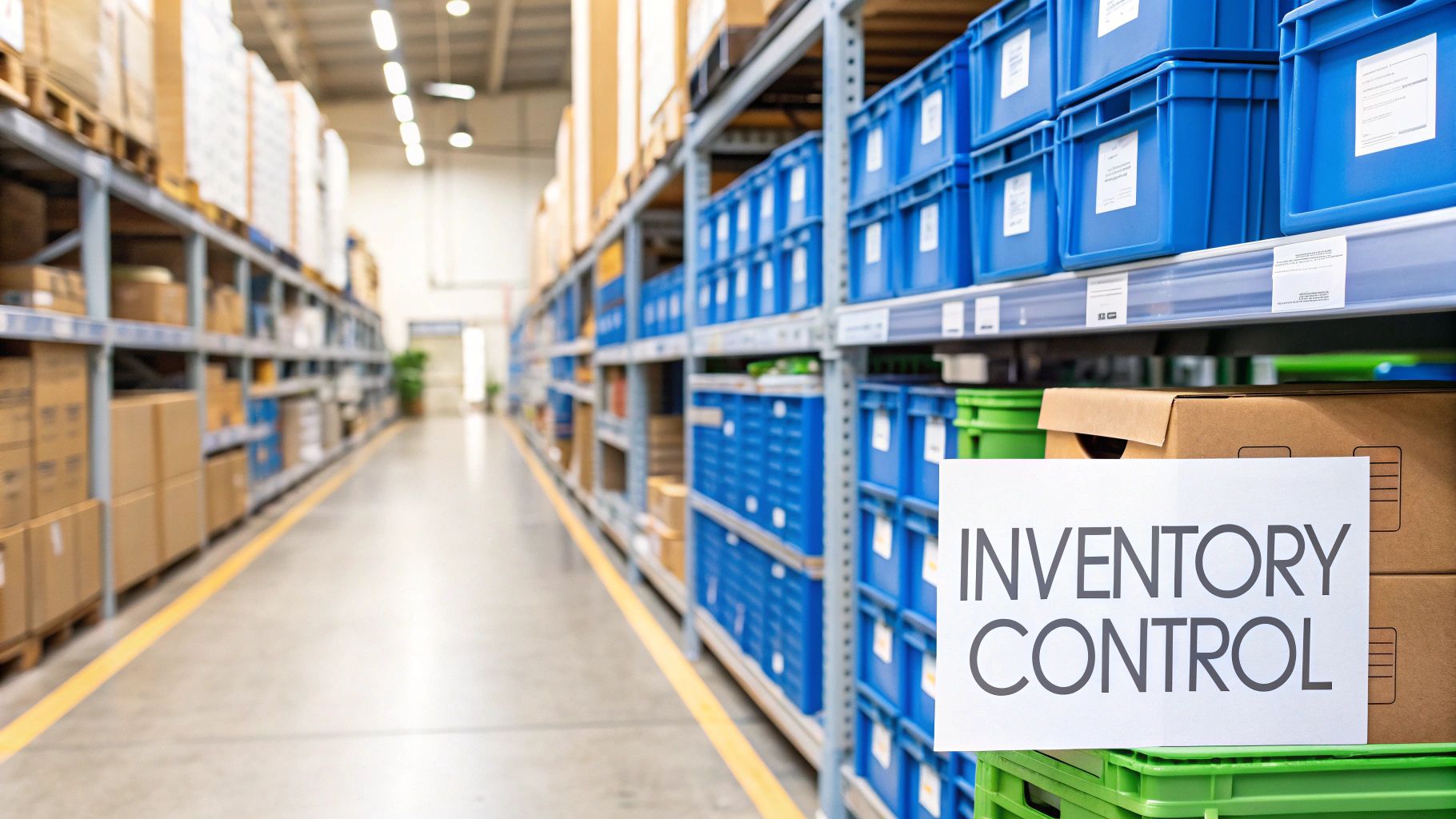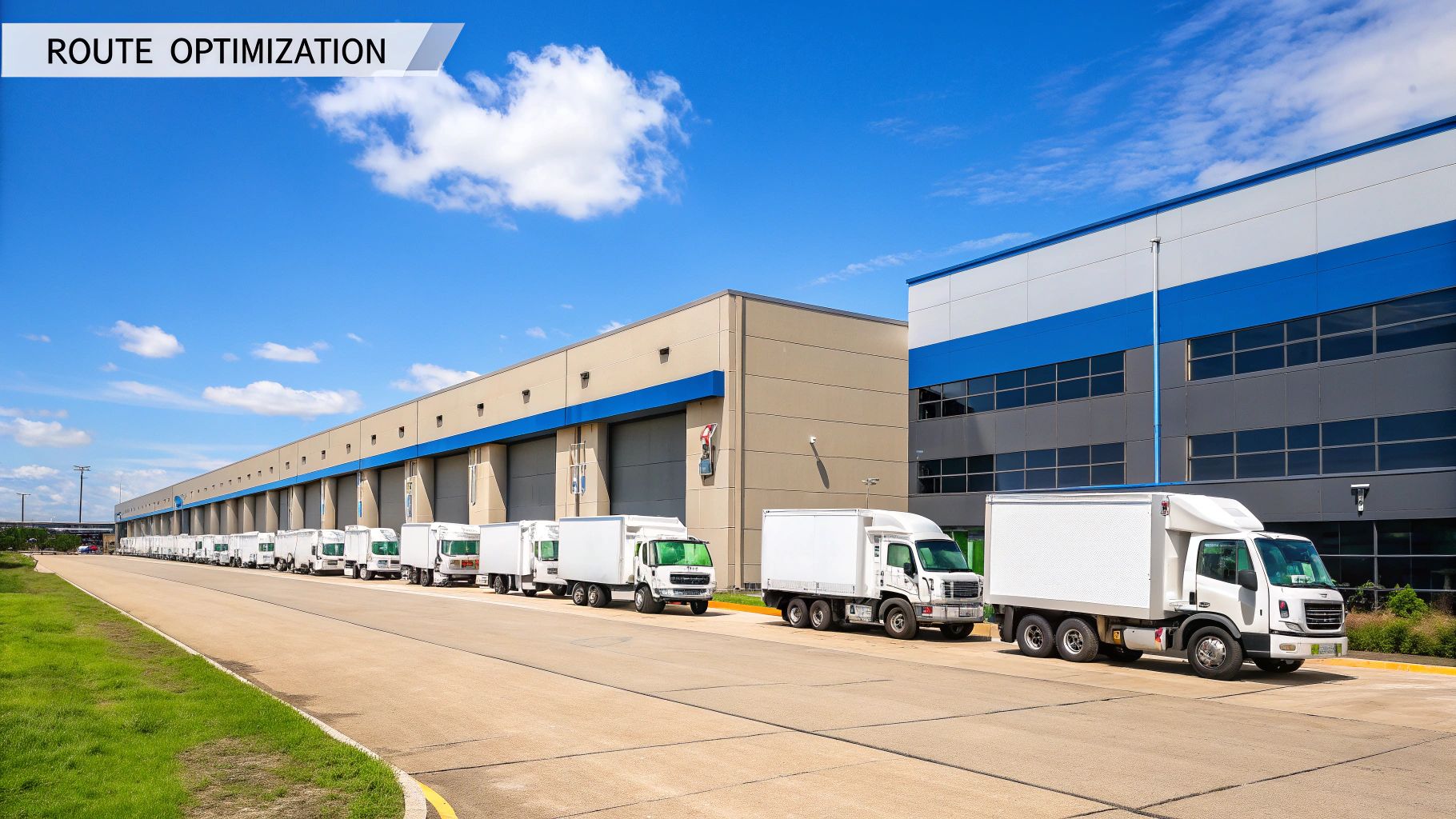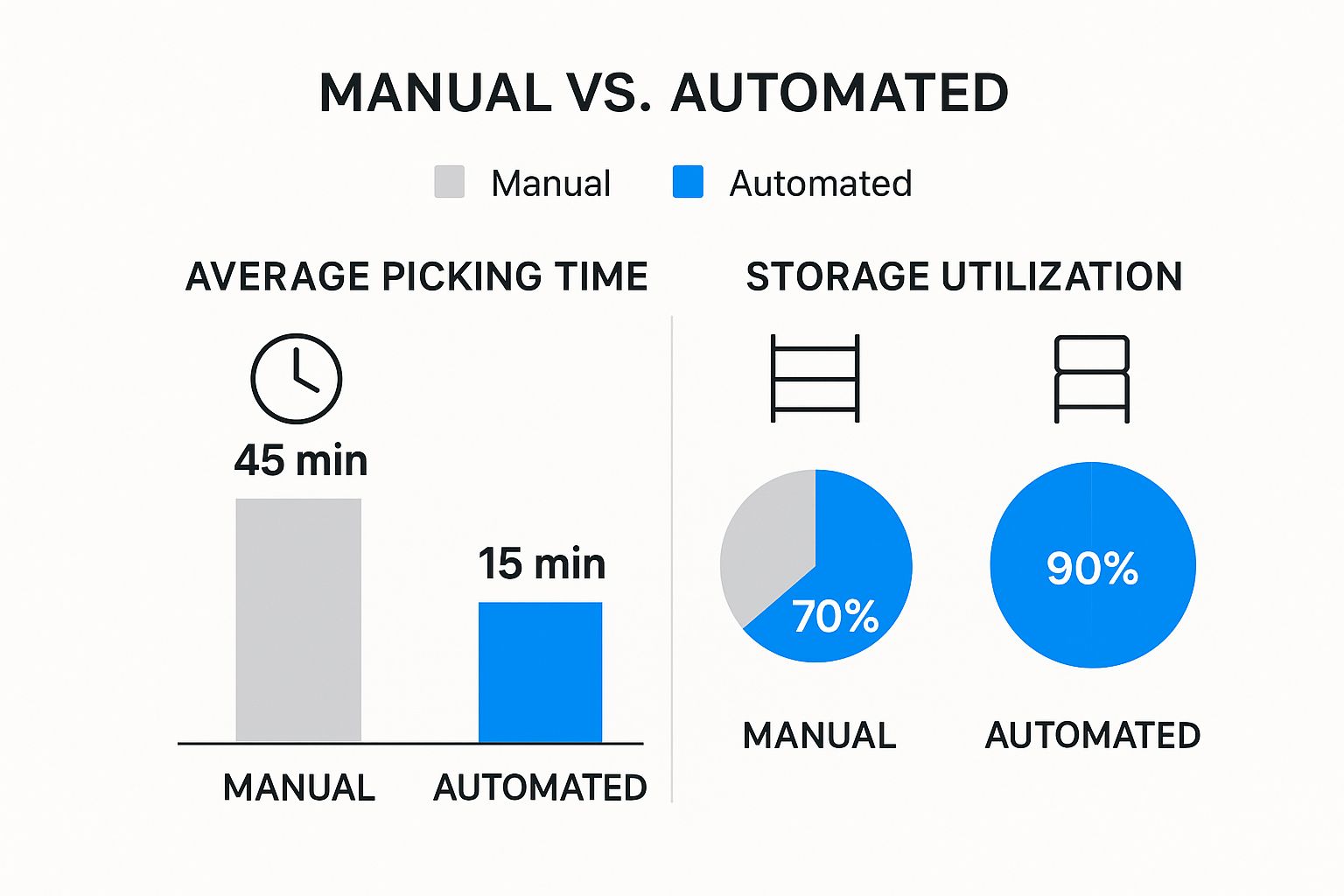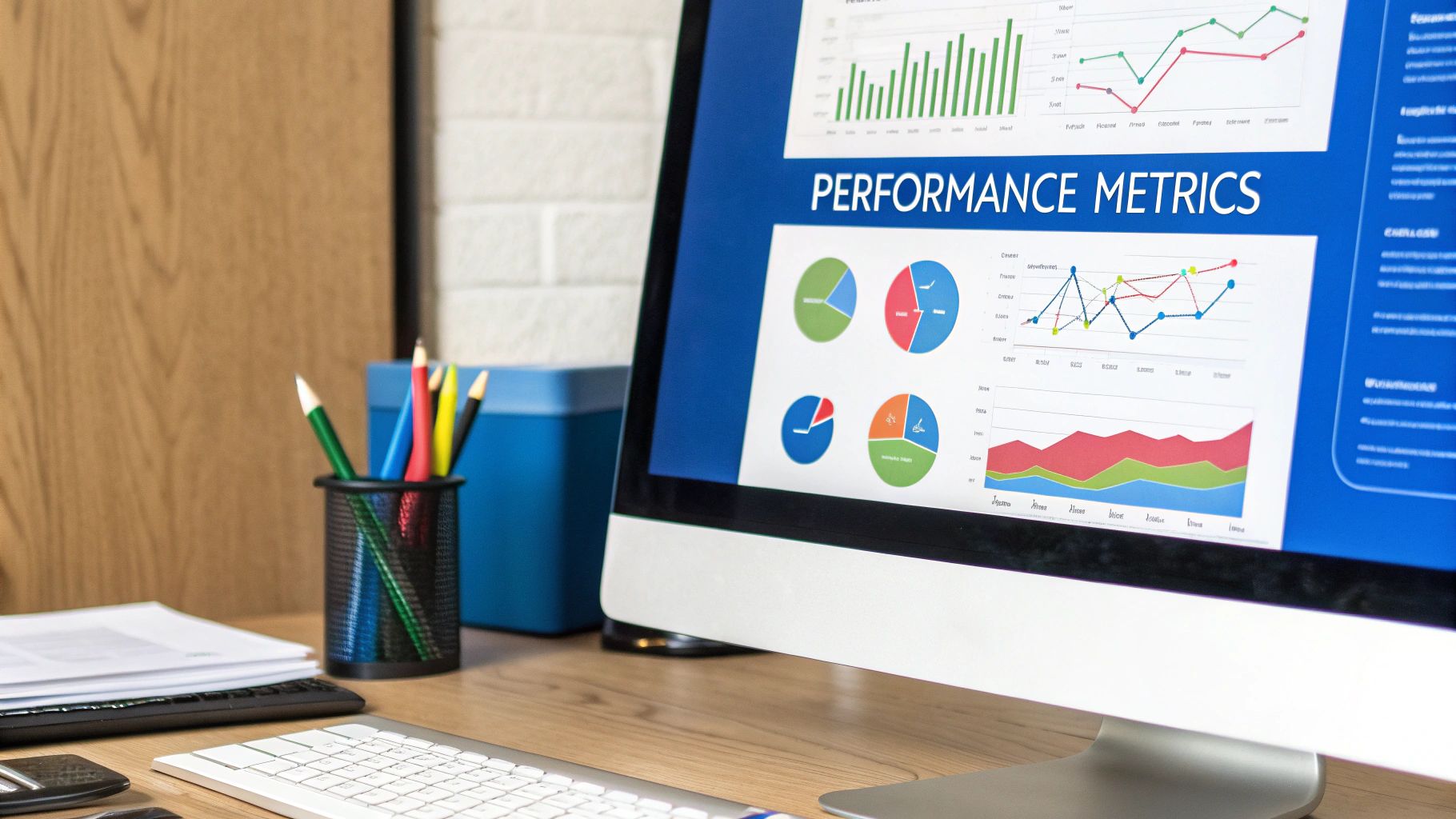When you boil it down, managing logistics operations is all about delivering on the promise you make to every single customer. It’s the entire journey of your products—from the moment they hit your inventory, to warehousing, fulfillment, and finally, shipping. Getting this right is the operational heartbeat of your e-commerce brand.
The success of your brand hinges on more than just having great products. It’s built on the promise you keep with every single order. This is where your logistics strategy transforms from a cost center into your most powerful tool for growth. When you get your operations right, you directly influence customer satisfaction, your brand's reputation, and your bottom line.
This isn't just about moving boxes from point A to point B. It’s about crafting an experience that builds loyalty and keeps customers coming back for more.
Logistics used to be a simple back-office function, an afterthought for many businesses. Not anymore. Today, it’s a key strategic differentiator. A slow, error-prone fulfillment process leads directly to frustrated customers, negative reviews, and lost sales.
On the flip side, fast, accurate, and transparent shipping delights customers and turns them into genuine advocates for your brand.
Think about it from your own experience as a customer. An order that arrives a day early, perfectly packed, maybe even with a personal touch? That's memorable. That positive experience is a direct result of well-managed logistics. By focusing on a few key areas, you can turn your operations into a true growth driver:
The core of a great brand experience lies in reliability. Customers remember how you made them feel, and a flawless delivery is one of the most tangible ways to show you value their business and respect their time.
The pressure to get this right is reflected in the market itself. The global logistics market was valued at approximately USD 378.26 billion in 2024 and is on track to nearly double, projected to reach close to USD 787.54 billion by 2032. You can find more details in this report on the logistics market growth.
This explosive growth highlights both the increasing complexity and the massive opportunity within the industry. For growing brands, this is where partnering with a third-party logistics (3PL) provider like Simpl Fulfillment becomes a game-changing move.
A great 3PL partnership gives you immediate access to advanced technology, optimized warehouse networks, and deep operational expertise, allowing you to compete on a much larger stage without the massive upfront investment. For more ideas on leveling up your operations, check out our guide on 10 powerful order fulfillment strategies for 2025.

Let's pull back the curtain and talk about what really happens inside the warehouse. Whether you're running your own show or have a logistics partner, getting this part right is everything. Solid warehouse and inventory processes are the bedrock of how you manage logistics operations, preventing the kind of costly mistakes that eat away at profits and destroy customer trust.
I've seen it firsthand. An online apparel store was constantly overselling its most popular items because of sloppy stock counts. The result? A flood of canceled orders and furious customers. Their fix was simple but powerful: they got serious about SKU management and started regular cycle counting.
By giving every single size and color variant its own unique SKU, they could finally track each item with precision. Paired with daily cycle counts—counting small, targeted inventory sections instead of one giant annual headache—they could spot and fix errors almost instantly. This simple shift can push inventory accuracy above 99%, which all but guarantees you won't sell products you don't have.
Beyond just getting the count right, you need smart strategies for managing what’s on your shelves. These aren't just textbook theories; they're practical methods that have a direct impact on your cash flow and your ability to ship orders on time.
First-In, First-Out (FIFO): This is a great place to start. FIFO ensures your oldest stock gets sold first. It’s absolutely essential for products with expiration dates, like supplements or beauty products, but it’s also a lifesaver for preventing wear-and-tear damage on any product line.
Intelligent Reorder Points: Stop guessing when to restock. A reorder point is a calculated minimum stock level that automatically triggers a new purchase order when hit. A good calculation factors in your supplier's lead time and a safety stock buffer to handle those unexpected sales spikes.
A well-run warehouse is more than just a storage space; it's a dynamic hub that dictates the speed and accuracy of your entire fulfillment process. Every efficiency gained here translates directly into a better customer experience and a healthier bottom line.
To keep your warehouse humming, you need to implement the right management techniques. For a deeper look at the core principles, checking out some essential storage facility management techniques can offer valuable insights that apply to any storage operation, helping you get the most out of your space and workflow.
Look, you can try to manage all this with a spreadsheet when you're just starting out, but that approach simply won't scale. This is where partnering with a 3PL like Simpl Fulfillment gives you a serious leg up. We use an advanced Warehouse Management System (WMS) that puts these critical tasks on autopilot.
Our WMS gives you a real-time, completely accurate view of your inventory across all our fulfillment centers. Instead of guessing your reorder points, the system analyzes your sales history to give you smart, data-backed recommendations. This approach helps you make confident buying decisions, avoiding both painful stockouts and the cash-flow killer of overstocking.
This kind of deep insight is a game-changer, especially for anyone selling on competitive marketplaces. If you're on Amazon, we've got even more tips on our blog for generating more revenue from your Amazon business.

Let's be blunt: picking a fulfillment partner is one of the most make-or-break decisions for your e-commerce brand. This isn't about just comparing price sheets. It's about finding a partner whose DNA matches yours—their capabilities have to align with your products, your customers, and where you plan to be in two years. A cheap partner who botches orders will cost you infinitely more in lost customers and reputation.
Your real goal is to find a Third-Party Logistics (3PL) provider that feels like a genuine extension of your own team. That requires a deep dive into what makes them tick: their tech, their warehouses, and their specific expertise. The quality of how you manage logistics operations is almost entirely dependent on the partners you bring on board.
It's easy to get swayed by a slick sales pitch. You need to push past the surface-level promises and dig into the operational nitty-gritty that directly impacts your customer experience and your bank account. A thorough vetting process is simply non-negotiable.
Here are the key areas I always tell brands to investigate:
For a more comprehensive checklist, check out our guide on evaluating fulfillment partners for your e-commerce business. It gives you a solid framework for asking the right questions.
One of the biggest perks of partnering with a 3PL is tapping into their shipping muscle. Trying to negotiate rates with carriers like FedEx or UPS as a small business is a losing battle. A 3PL, on the other hand, pools the shipping volume of all its clients, giving them serious leverage to lock in discounted rates you could never dream of getting alone.
This also unlocks a multi-carrier shipping strategy. Instead of being stuck with one carrier, a good 3PL can automatically shop for the best rate on every single order, weighing cost, speed, and destination. That flexibility is a massive competitive advantage.
Real-World Scenario: A subscription box company was bleeding money on slow, expensive cross-country shipments from their single warehouse. By switching to a 3PL with warehouses on both the East and West coasts, they immediately slashed average delivery times by two days and cut shipping costs by 22%.
This kind of strategic thinking about fulfillment is only getting more important. In fact, the global logistics sector is expected to grow by another 4.1% in 2025, fueled by relentless consumer demand. This growth just hammers home the need for an efficient, scalable fulfillment strategy if you want to stay in the game.
Modern logistics runs on technology, and it's far more accessible than you might think. For growing e-commerce brands, integrating the right software is the key to unlocking efficiency, cutting costs, and keeping customers happy. When you manage logistics operations effectively, you're not just moving products; you're building a smarter, more resilient business.
This all starts with getting comfortable with the core software that powers a modern supply chain. You’ll often hear acronyms like WMS and TMS thrown around. A Warehouse Management System (WMS) is essentially the brain of the warehouse, tracking every single item in real time. A Transportation Management System (TMS) takes over once a package leaves the building—it handles everything from optimizing shipping routes to managing carriers and tracking deliveries.
But the real magic happens when you move beyond those basic systems. Artificial Intelligence (AI) and the Internet of Things (IoT) are no longer just industry buzzwords; they are practical tools making a huge impact on the warehouse floor.
For instance, AI algorithms can analyze your past sales data to forecast future demand with surprising accuracy. This prevents both costly stockouts and the cash-flow drain of overstocking. At the same time, IoT sensors on shipments can provide real-time location and condition data, so you know exactly where your products are and if they’ve been exposed to damaging temperatures or impacts. That kind of visibility is invaluable.
The data below clearly shows the measurable impact of this kind of automation. Just compare the performance metrics of a warehouse operating manually versus one with an automated system.

As you can see, automation dramatically cuts down picking time and maximizes storage space. These are two of the most critical factors for operational efficiency and, ultimately, your profitability.
Let's look at a real-world example. Imagine an online gadget store struggling to keep up with orders. The owner was spending hours every single day manually exporting orders from Shopify, emailing them to a warehouse, and then, hours later, uploading tracking numbers back into Shopify. It was slow, riddled with errors, and completely unsustainable for growth.
By partnering with a 3PL like Simpl Fulfillment, they integrated their Shopify store directly with our system. Now, the moment a customer clicks "buy," the order syncs automatically, gets picked, packed, and shipped. The tracking information is then pushed back to Shopify and sent to the customer without the owner lifting a finger.
This single integration freed up 15-20 hours per week, allowing them to finally focus on what they do best: marketing and product development. You can get a much deeper look into how this works by reading our guide on using technology for logistics automation.
To get a clearer picture of the tools involved, here's a simple breakdown of the essential technologies that make modern logistics work.
These technologies, once only available to massive corporations, are now the backbone of efficient e-commerce operations for brands of all sizes.
Embracing technology isn't about replacing people. It's about empowering your team to work on higher-value tasks by automating the repetitive, manual processes that slow down growth and create friction for your customers.
This isn't just a trend; it's the direction the entire industry is headed. By 2025, more logistics companies will be adopting advanced tech like AI, IoT, and warehouse automation to streamline their operations. And when you're looking at the bigger picture, understanding the core business benefits of fleet management can also reveal significant opportunities for efficiency, even if you're not managing the fleet yourself.
You can't fix what you can't see. That old saying is the heart of scaling your logistics operations. When customer expectations are sky-high, you can't rely on gut feelings or rough estimates to make critical decisions. You need cold, hard data.
This means looking past your total shipping spend and digging into the specific numbers that tell the real story of your fulfillment health. Think of these metrics like the dashboard in your car—they tell you how fast you're going, if you're about to run out of fuel, and whether the engine is overheating. Without them, you're just driving blind.
To get a clear, actionable picture of how your operations are really doing, start with this handful of vital metrics. These KPIs directly impact both your profit margins and your customers' happiness.
Tracking logistics KPIs isn't just about spotting problems—it's about finding opportunities. When you see your on-time delivery rate dip in a specific region, it might be the data-backed signal you need to move inventory to a 3PL partner's warehouse in that area.
Collecting these numbers is just step one. The real magic happens when you use that data to make informed choices. By setting up a simple performance dashboard, whether it's in a spreadsheet or through your 3PL’s analytics portal, you can start to visualize trends and connect the dots.
For instance, maybe you notice your Cost Per Shipment spikes every single November. With that data in hand, you can get ahead of the problem next year. You could adjust your holiday marketing, or maybe explore different, more economical shipping services during that peak season to protect your margins. This is how you shift from being reactive to proactively managing your logistics.
Working with a tech-forward 3PL like Simpl Fulfillment gives you this power right out of the box. Our platform includes a real-time dashboard that tracks these KPIs automatically, saving you the headache of building it all from scratch. It provides the clarity you need to scale with confidence, knowing every move you make is backed by solid data.

As you start to get a real handle on your logistics, you’re going to run into questions. It’s inevitable. Even with the perfect strategy on paper, the day-to-day realities of e-commerce always throw a few curveballs.
We’ve seen it all, so we’ve put together answers to some of the most common questions we hear from growing brands. Think of this as your field guide for those tricky situations that pop up right after you think you’ve got everything figured out.
A customer’s experience doesn’t stop once the package lands on their doorstep. It carries on through the entire time they own your product, and that absolutely includes returns. The smartest way to look at your returns process is not as a cost center, but as one of your most powerful customer retention tools.
Make it dead simple. Your return instructions should be crystal clear and the process itself completely hassle-free.
This is one of those areas where a 3PL partner is worth their weight in gold. They already have efficient, battle-tested workflows for receiving, inspecting, and processing returned items. They can tell you in a heartbeat if a product is good to go back on the shelf, needs a little TLC, or should be written off. This saves you an incredible amount of time and stops the chaos of returns from eating into your profit margins.
There’s nothing more frustrating than getting a shipping invoice that’s way higher than you budgeted for. Nine times out of ten, it’s because of sneaky fees that weren't obvious upfront. Keep an eye out for these common culprits:
A great 3PL will get out in front of these charges for you. They do it by negotiating much better terms with carriers and by helping you tweak your packaging to sidestep those costly DIM weight fees.
The first step to outsourcing fulfillment isn't shopping for prices—it's understanding your own pain points. Document your current processes and pinpoint exactly what's holding you back. Are shipping costs too high? Is fulfillment taking too long? Knowing the specific problem you need to solve is crucial for finding a 3PL that is the right fit for your brand's unique needs.
This is a totally valid concern we hear all the time. The fantastic news is that you don't need to build an enterprise-level tech stack from the ground up. The single most effective way for a growing business to get this kind of power is by partnering with a tech-forward 3PL.
When you work with a company like Simpl Fulfillment, you get instant access to our multi-million dollar technology platform. Our advanced WMS and TMS become your WMS and TMS. This is one of the biggest leaps forward you can make by outsourcing—you get world-class capabilities for a tiny fraction of what it would cost to build and maintain them on your own.
Ready to stop worrying about logistics and start focusing on growth? Simpl Fulfillment provides the technology, expertise, and dedicated support to handle every aspect of your fulfillment, from same-day shipping to custom packaging. Let us show you how seamless and scalable your operations can be.
Discover how Simpl Fulfillment can elevate your brand today!